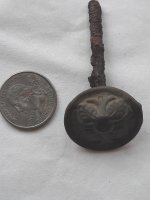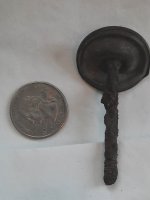Older The Better
Silver Member
- Apr 24, 2017
- 3,370
- 6,630
- Detector(s) used
- Whites Eagle Spectrum
- Primary Interest:
- All Treasure Hunting
Hi guys I don’t have much chance to make it over to this forum since I hunt a small little piece of land in se Kansas that was settled after the civil war. I’ve got a site I suspect is a house or structure belonging to a civil war veteran. I recently found an 1869 penny. I have a shield nickel without a visible date, I’ve found a civil war cavalry button and what cannonball guy once id’d as a part of an artillery shell…. Other items include stove parts, a thimble, possibly part of an octagon barrel, a sad iron, and a spoon handle… anyway I found this today and I’m excited but cautious. I think it looks great for a j hook but I thought I’d ask people that probably know better, I don’t see any reeding on the side and no words on it like I’d expect on a wick turner. there is a mold seam and maaaaybe a star on the shaft… I’m hoping for some good news but I wouldn’t be surprised if a j hook is commonly misidentified… for what it’s worth Kansas farm field, so I don’t think it be a brass nail from a boat or anything like that. Biggest thing I don’t like is it seems short if it had been straightened out.










Amazon Forum Fav 👍
Upvote
4








